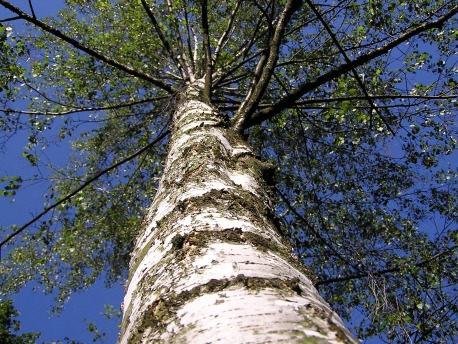Birch ask more of their owners than many other species of tree. Why?
Birch ask more of their owners than many other species of tree. Why? Almost all birch grow naturally in moist cool northern climates, near water, and if not near actual water then in moist soil. That is not a description of the Calgary area, this windswept dry harsh buffalo pasture we call home. There are a couple of native birch in this area but most of us wouldn't recognize them as birch trees. The bog birch is short and shrubby and grows in wetlands. The other is a drought-resistant large shrub called black birch or river birch, which can tolerate serious drought.
The tree most of us think of as the ideal birch is the cut-leaf weeping birch from northern Europe. Very popular here, this tree has the highest water requirements of any tree growing in Calgary. Left alone without regular plentiful water, it will decline and die. I don't believe there is one decent birch in the city that isn't the recipient of regular love in water form. There are many struggling birch in our city, and if you see a large healthy beauty you know that someone who has made peace with their water meter regularly tends to its needs.
A birch's main problem is the lawn it is planted in. Nature has given the birch its love of water; part of that gift is a shallow surface root system, so that it can be near water but not drown. The roots of the tree and the roots of the lawn occupy a lot of the same space, and the lawn is very aggressive. A birch in trouble can instantly be spotted by the telltale large brown circle of failing grass underneath it. While it still has the strength, the birch is desiccating the lawn and the circle is a representation of the size of the tree's strong water-gathering root system.
Another planting scheme that usually doesn't go well for the birch is the removal of the lawn and the installation of a garden. The perennials usually have much different needs than the tree and they are given a priority. I have seen plenty of these with the lawn and gardens doing well while the centerpiece birch is failing.
How much water are we talking of? The city with their water-conserving bias speaks of filling a Frisbee. That is an inch a week. I would see that as a minimum for the lawn alone and probably not enough during a heat wave. I, with my tree-loving bias, would say two inches per week to ten days. Any birch in an unhappy looking lawn is unhappy. Any birch without thick jade-green foliage is in trouble.
Rain in Calgary, when it comes, can be a major benefit to birch and, of course, all trees. With the ground of most suburban properties being 60% open land and 40% covered with house, the amount of rainfall on the roof is substantial. Direct your own and neighbors downspouts to outflow near trees. Changes to drainage/eaves trough systems are cheap compared to the amazing amount of free rainfall that can be utilized.
To take care of a birch and water it properly doesn't mean watering your whole property to birch standards. Focus on the area where the birch is planted. The drip line is the place where the farthest outreaching branches extend. It is inside this circle where the water is really needed.









